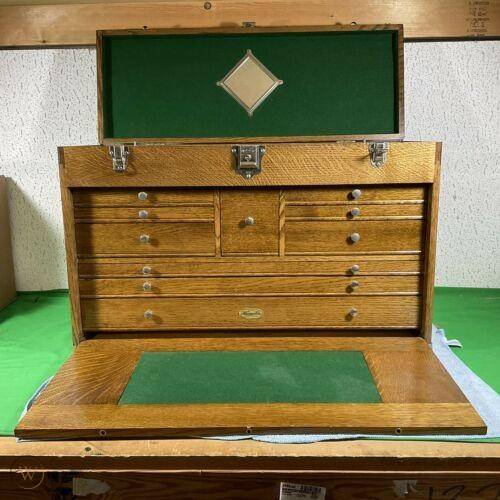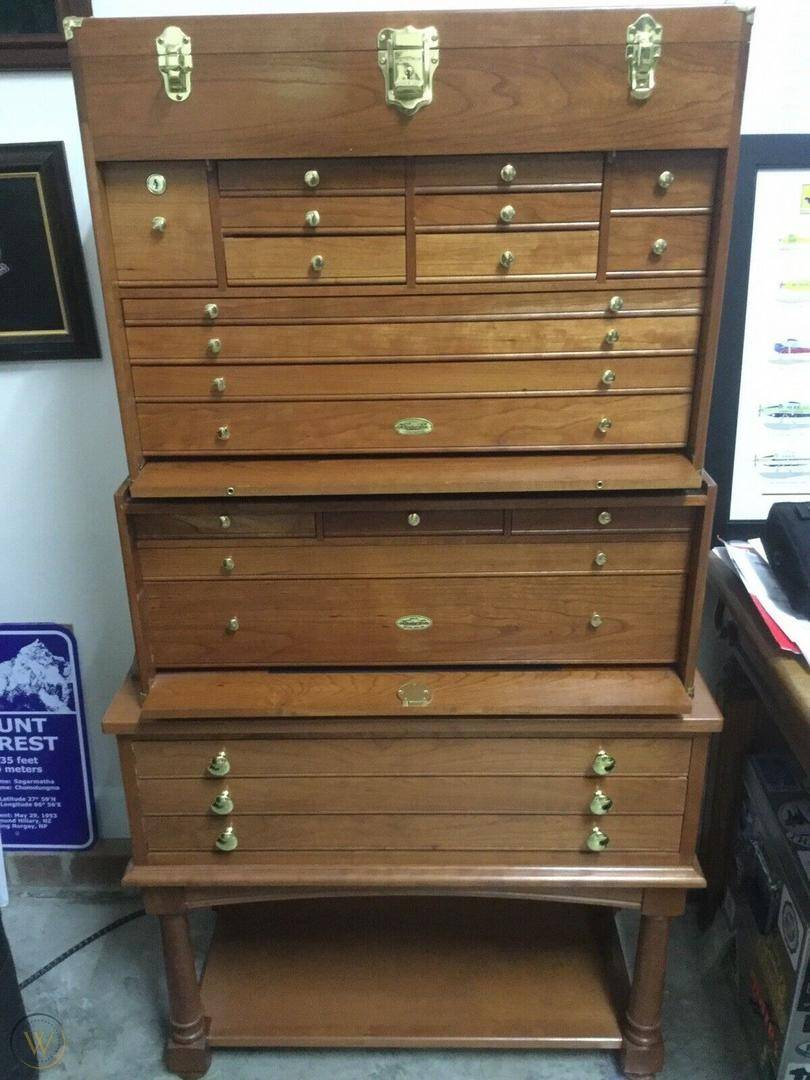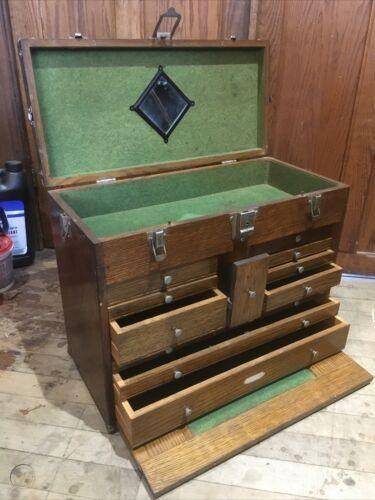
Harry Gerstner designed and built the first Gerstner tool chest about 1904. A 21-year-old journeyman in Dayton, Ohio, he wanted a sturdy, customized carrying case for his pattern-making tools.
Gerstner’s chest was oak with a stack of precisely fitting drawers, metal hardware, and a leather handle. Fellow workers admired the piece and immediately wanted their own. Before long, Harry was selling them door-to-door after work. With a $100-bonus from his employer, he started a manufacturing company.
Harold Gerstner & Sons has occupied the same brick factory for more than a century. It’s still a family-owned business. And while the company has introduced new models over the years and retired others, all Gerstner chests bear a strong family resemblance.
The smallest are designed for portability. Bigger come with additional drawers. Largest of all is the Pro-Series, a stack of two or three cabinets and a base that enables them to be wheeled around a shop or worksite.
These days Gerstner chests are not only used to house carpentry and machine-shop tools; owners may use them to organize collectible coins, jewelry, pocket knives, craft supplies, hunting gear, fishing lures, or even a prized marble collection. Other owners simply admire them as decorative objects—a slightly steam-punk cousin of the multi-drawered apothecary cabinet.
For generations, owners have passed down their Gerstner chests to sons and grandsons—and, these days, to daughters. But that’s not the only path to ownership. Collectors can also score Gerstners in the antiques and vintage market, where they’re abundant, though not cheap.

What Makes Gerstner Tool Chests So Desirable?
At least three factors contribute to the appeal of a Gerstner chest.
- They’re utilitarian.
Harry Gerstner designed the first chest to house his own patternmaking tools. He wanted not only to store them but to also protect them. Tools are that dumped into a drawer or jostled about gradually dullen. Machinists and patternmakers treat their implements—which might cost them $6,000 or more today— with the utmost care. The drawers of a Gerstner chest are lined in thick green felt, so the contents don’t bang around. Variously sized drawers accommodate specific tools. Some models have a central “Bible Drawer” to hold Machinery’s Handbook, the leading guidebook in the trade. (See photo above.)
The front lid of the chest folds down into a felt-lined writing shelf and can also tuck neatly under the bottom drawer. Perhaps the most charming feature is the diamond-shaped mirror inside the front lid. Some say it was put there in case the user─in the days before safety glasses― got something in his eye. Another theory holds that the mirror allowed the worker to see if the boss was looking.
- They’re finely constructed.
Precision is everything in these trades. While a fine-woodworker might measure things to the 32nd of an inch, machinists, tool and dye makers, and patternmakers calibrate to a thousandth. Such exacting standards make them appreciate the visible craftsmanship of a Gerstner tool chest. Most often made of quarter-sawn oak, they’re also available in woods like walnut and cherry. The hardware is brass or nickel. Drawers glide noiselessly. The latches close with a sonorous clack. The carrying handle is sheathed in leather, much like a vintage suitcase.
- They’re handsome.
People are drawn to Gerstner tool chests for the same reasons they collect other useful objects from the past― wooden trenchers, post office boxes, cobblers’ benches, and pitchforks. Well-worn and functionally designed, they tell a story about the people who once used them.
Like fine furniture, Gerstner tool chests age well. Their color mellows; the latches and drawer-pulls develop a soft patina. In fact, their design is reminiscent of Stickley, Roycroft, and other makers from the Arts and Crafts movement.
A Gerstner of Your Own
Admirers of Gerstner chests can buy them new, directly from the company or a high-end retailer like Garret Wade. The most iconic model, the Journeyman Chest, retails for $1,995 new.
In addition to the U.S.-made products, less expensive versions, manufactured in Asia, are sold under the Gerstner International label for about one-third the price. While the materials are slightly less luxe than in the USA-made ones, these chests still look unmistakably Gerstner.

Factors That Affect the Price of an Antique or Vintage Gerstner
The secondary market for vintage Gerstners is strong. Five to ten new ones pop up every day on eBay.
Age, size, condition, rarity, and backstory can drive the resale price up or down. Because the cases had locks to protect their precious contents, some owners, inevitably, lost the keys. The chests were built to last, and they definitely do so. But owners can send them back for restoration, much as one does a classic car. The company can also fabricate a replacement key or provide replacement parts.
When Gerstner founded his company, several competitors made similar products, sometimes with knock-off features. Occasionally these are mistaken for Gerstners. There are clear differences, however, and the company website offers a handy tool for authentication.
Who Collects Gerstner Tool Chests?
Harry Gerstner’s earliest customers were patternmakers, tool-and-dye makers, and machinists who worked in Dayton’s then-bustling factories. Today just five percent of the tool chests are bought by tradespersons. Another forty percent goes to hobbyists and weekend-craftspeople. The remainder are buyers who see the chests to display as “functional art” or want to organize and store some kind of collection. More than once, a bereaved family has ordered a custom-designed chest with faux drawers. The purpose: to hold the ashes of a deceased relative who “always wanted a Gerstner chest.”
Recently, I visited a skilled woodworker who had posted a three-section Gerstner International chest online. He’d bought it from a man who was selling off his father-in-law’s estate. In immaculate condition, it had been used solely for hand-tied fishing flies. That chest would have held a lot of them.
The woodworker offered to show me his other Gerstner, a vintage chest he was using in his workshop out back. He led me to a stone-and-shingle barn that housed his post-retirement activities. His workspace was large and brilliantly lit by high, clerestory windows. It reminded me of a cathedral.
I surveyed the expanse of gleaming power saws, drills, sanders, lathes and noted the meticulous rows of hand tools. Then I spotted the antique Gerstner chest sitting off in the corner. I asked what he kept in it.
“My best tools,” he said.`
Mary Young is a Boston-based researcher and writer. She vividly remembers her first trash-picking adventures in grade school. She was hooked and has been a hunter and collector ever since.
WorthPoint—Discover Your Hidden Wealth®
The post Antique Tool Chests to Die For first appeared on WorthPoint.